Themed collection RSC Chemical Biology Transparent Peer Review Collection

Lysine methyltransferase inhibitors: where we are now
An updated outlook on protein lysine methyltransferase-disclosed modulators is presented, reporting their potency, mechanism of action and eventual use in clinical and preclinical studies.
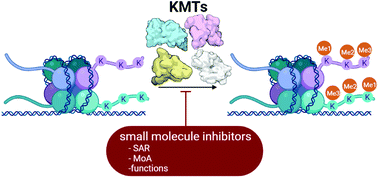
RSC Chem. Biol., 2022,3, 359-406
https://doi.org/10.1039/D1CB00196E
Enabling the next steps in cancer immunotherapy: from antibody-based bispecifics to multispecifics, with an evolving role for bioconjugation chemistry
Immune targets and antibodies for cancer immunotherapy are reviewed. Multispecific antibody formats and bioconjugation chemistry to generate them are discussed.

RSC Chem. Biol., 2022,3, 140-169
https://doi.org/10.1039/D1CB00082A
Cyclic peptide drugs approved in the last two decades (2001–2021)
In this mini-review, we summarized the chemical structure, mechanism of action, and metabolism of cyclic peptide drugs approved in the last two decades. We also examined factors important for the development and utilization in clinical situations.

RSC Chem. Biol., 2022,3, 18-31
https://doi.org/10.1039/D1CB00154J
Insights into auto-S-fatty acylation: targets, druggability, and inhibitors
Posttranslational S-fatty acylation (or S-palmitoylation) modulates protein localization and functions, and has been implicated in neurological, metabolic, and infectious diseases, and cancers.

RSC Chem. Biol., 2021,2, 1567-1579
https://doi.org/10.1039/D1CB00115A
Targeting the RNA demethylase FTO for cancer therapy
Chemical modulation of the RNA m6A demethylase FTO for cancer therapy.

RSC Chem. Biol., 2021,2, 1352-1369
https://doi.org/10.1039/D1CB00075F
19F NMR viewed through two different lenses: ligand-observed and protein-observed 19F NMR applications for fragment-based drug discovery
19F NMR has emerged as a powerful tool in drug discovery, particularly in fragment-based screens.

RSC Chem. Biol., 2021,2, 1312-1330
https://doi.org/10.1039/D1CB00085C
Reactive oxygen species, proinflammatory and immunosuppressive mediators induced in COVID-19: overlapping biology with cancer
Mitochondria-targeted drugs inhibit cancer and COVID-19 mechanisms.

RSC Chem. Biol., 2021,2, 1402-1414
https://doi.org/10.1039/D1CB00042J
Direct targeting of TDP-43, from small molecules to biologics: the therapeutic landscape
Given the therapeutic interest of targeting TDP-43, this review focuses on the current landscape of strategies, ranging from biologics to small molecules, that directly target TDP-43. Regions targeted are shown on the 3D structure of RNA-bound TDP-43.

RSC Chem. Biol., 2021,2, 1158-1166
https://doi.org/10.1039/D1CB00110H
Wnt signaling activation: targets and therapeutic opportunities for stem cell therapy and regenerative medicine
Overview of the Wnt signaling pathway and targets of Wnt activators.

RSC Chem. Biol., 2021,2, 1144-1157
https://doi.org/10.1039/D1CB00063B
Recent developments and applications of quantitative proteomics strategies for high-throughput biomolecular analyses in cancer research
Various quantitative strategies can be utilized in mass spectrometry (MS)-based proteomic investigations. Here we explore recent applications of quantitative MS-based strategies and the resulting advances in the areas of prostate, pancreatic, breast and ovarian cancer research.
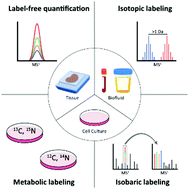
RSC Chem. Biol., 2021,2, 1050-1072
https://doi.org/10.1039/D1CB00039J
Optical chemosensors for the detection of proximally phosphorylated peptides and proteins
This review details optical detection methods for proximal multi-site phosphorylation, a critical post-translational modification in protein biology.

RSC Chem. Biol., 2021,2, 815-829
https://doi.org/10.1039/D1CB00055A
Nanobodies as in vivo, non-invasive, imaging agents
In vivo imaging has become in recent years an incredible tool to study biological events and has found critical applications in diagnostic medicine.

RSC Chem. Biol., 2021,2, 685-701
https://doi.org/10.1039/D1CB00023C
Investigation of the biological functions of heparan sulfate using a chemoenzymatic synthetic approach
Heparan sulfate (HS) is a highly sulfated polysaccharide playing essential physiological and pathophysiological roles in the animal kingdom.

RSC Chem. Biol., 2021,2, 702-712
https://doi.org/10.1039/D0CB00199F
Crosslinker-modified nucleic acid probes for improved target identification and biomarker detection
Crosslinker-modified nucleic acid probes are promising substitutes for regular oligonucleotide probes in hybridization-based assays, as they allow a more selective and efficient detection of nucleic acid targets and nucleic acid biomarkers.
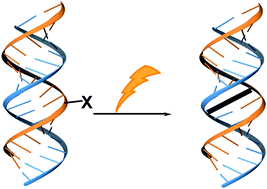
RSC Chem. Biol., 2021,2, 410-422
https://doi.org/10.1039/D0CB00236D
Design and synthesis of metabolic chemical reporters for the visualization and identification of glycoproteins
This review details a brief history of the synthesis and characterization of metabolic chemical reporters used to study glycosylation before describing recent applications and finishing with considerations and limitations of reporter molecules.

RSC Chem. Biol., 2021,2, 306-321
https://doi.org/10.1039/D1CB00010A
Modulators of protein–protein interactions as antimicrobial agents
This review describes recent efforts towards the modulation of protein–protein interactions in infectious bacteria.

RSC Chem. Biol., 2021,2, 387-409
https://doi.org/10.1039/D0CB00205D
Biological functions of supramolecular assemblies of small molecules in the cellular environment
Supramolecular assemblies of small molecules, exhibiting emergent properties, are becoming a new and dynamic molecular platform for biological functions and for developing novel therapeutic approaches.
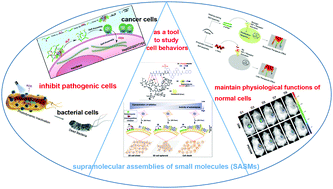
RSC Chem. Biol., 2021,2, 289-305
https://doi.org/10.1039/D0CB00219D
DNA folds threaten genetic stability and can be leveraged for chemotherapy
Alternative DNA structures (including G-quadruplexes and DNA junctions) represent promising targets for combinatorial chemotherapeutic treatments aiming at fostering genomic instability and impeding DNA repair.
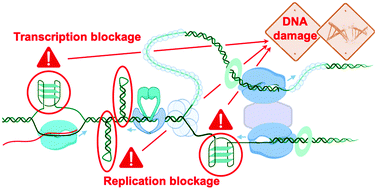
RSC Chem. Biol., 2021,2, 47-76
https://doi.org/10.1039/D0CB00151A
Natural product scaffolds as inspiration for the design and synthesis of 20S human proteasome inhibitors
The 20S proteasome is a valuable target for the treatment of a number of diseases including cancer, neurodegenerative disease, and parasitic infection.

RSC Chem. Biol., 2020,1, 305-332
https://doi.org/10.1039/D0CB00111B
The chemical biology of IL-12 production via the non-canonical NFkB pathway
Interleukin-12 (IL-12) has emerged as an attractive cytokine for cancer therapy because it has direct anti-cancer effects and additionally plays a critical role in enhancing checkpoint inhibitors.

RSC Chem. Biol., 2020,1, 166-176
https://doi.org/10.1039/D0CB00022A
Matters of class: coming of age of class III and IV lanthipeptides
In this review, we give a concise overview of the known biosynthetic princples of class III and IV lanthipeptide synthtases.

RSC Chem. Biol., 2020,1, 110-127
https://doi.org/10.1039/D0CB00073F
Towards optimizing peptide-based inhibitors of protein–protein interactions: predictive saturation variation scanning (PreSaVS)
An experimentally validated approach for in silico modification of peptide based protein–protein interaction inhibitors is described.

RSC Chem. Biol., 2021,2, 1474-1478
https://doi.org/10.1039/D1CB00137J
Protein–protein interaction based substrate control in the E. coli octanoic acid transferase, LipB
Lipoic acid, an essential cofactor produced in all organisms, diverts octanoic acid from type II fatty acid biosynthesis through a highly specific protein–protein interaction. This study characterizes how different substrates influence this interface to control chain length specificity.
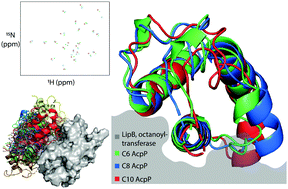
RSC Chem. Biol., 2021,2, 1466-1473
https://doi.org/10.1039/D1CB00125F
Rational design of a stapled JAZ9 peptide inhibiting protein–protein interaction of a plant transcription factor
A rationally designed stapled JAZ peptide selectively inhibited MYCs, master-regulators of the jasmonate signaling in Arabidopsis thaliana. It is proposed as a novel chemical tool for the analysis of MYC related jasmonate signaling.
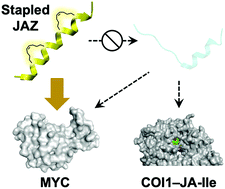
RSC Chem. Biol., 2021,2, 499-502
https://doi.org/10.1039/D0CB00204F
Tranylcypromine specificity for monoamine oxidase is limited by promiscuous protein labelling and lysosomal trapping
Chemical proteomics and cellular imaging reveal lysosomal trapping of tranylcypromine which can be largely reverted by the addition of lysosomotropic drugs.

RSC Chem. Biol., 2020,1, 209-213
https://doi.org/10.1039/D0CB00048E
Synthetic hyperacetylation of nucleosomal histones
A chemical catalyst system enabling high-yielding and comprehensive lysine acetylation of nucleosomal histones was developed as an epigenetics tool.

RSC Chem. Biol., 2020,1, 56-59
https://doi.org/10.1039/D0CB00029A
Inner residues of macrothiolactone in autoinducer peptides I/IV circumvent spontaneous S-to-O acyl transfer to the upstream serine residue
In AIP-I/IV, single Gly mutation at the thiolactone induces S-to-O acyl shift to yield a corresponding ring-expanded lactone form.
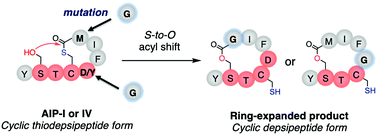
RSC Chem. Biol., 2022,3, 295-300
https://doi.org/10.1039/D1CB00225B
Inhibition of chloroplast translation as a new target for herbicides
The antibiotic linezolid is an effective herbicide pre- and post-emergence. Making a series of analogues, we partly separated its antibacterial and herbicidal activities, making chloroplast translation a potential new herbicide mode of action.
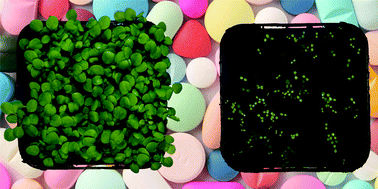
RSC Chem. Biol., 2022,3, 37-43
https://doi.org/10.1039/D1CB00192B
A ruthenium–oligonucleotide bioconjugated photosensitizing aptamer for cancer cell specific photodynamic therapy
Ruthenium complexes have emerged as a promising class of compounds for use as photosensitizers in photodynamic therapy. Direct conjugation to aptamers enhances their therapeutic usefulness by conveying specificity to Ru-mediated PDT.

RSC Chem. Biol., 2022,3, 85-95
https://doi.org/10.1039/D1CB00146A
Identification of fragments binding to SARS-CoV-2 nsp10 reveals ligand-binding sites in conserved interfaces between nsp10 and nsp14/nsp16
By fragment screening using X-ray crystallography we identified four ligands revealing ligand-binding sites in interfaces between SARS-CoV-2 nsp10 and nsp14/nsp16. The nsp14/10 interaction is weak and therefore could be disrupted by small molecules.
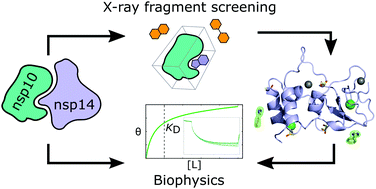
RSC Chem. Biol., 2022,3, 44-55
https://doi.org/10.1039/D1CB00135C
Activation of a G protein-coupled receptor through indirect antibody-mediated tethering of ligands
The use of antibodies to target membrane receptors enables specific and potent activation. But antibodies with appropriate specificity can be lacking. We present methods for targeting receptors without target-specific antibodies.

RSC Chem. Biol., 2021,2, 1692-1700
https://doi.org/10.1039/D1CB00118C
Alkyl vs. aryl modifications: a comparative study on modular modifications of triphenylphosphonium mitochondrial vectors
Alkyl chain extension and aryl methylation can be employed to enhance mitochondrial uptake in triphenylphosphonium vectors. Here we compare these complementary strategies and their mitochondrial-targeting effects using a modular synthetic approach.
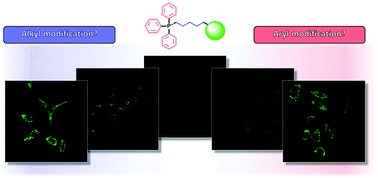
RSC Chem. Biol., 2021,2, 1643-1650
https://doi.org/10.1039/D1CB00099C
Members of the Legionella pneumophila Sde family target tyrosine residues for phosphoribosyl-linked ubiquitination
During infection, Legionella pneumophila translocates hundreds of effectors into host cells. Among these, the Sde family effector SdeC catalyzes atypical ubiquitination of host targets at tyrosine, not only serine, residues.
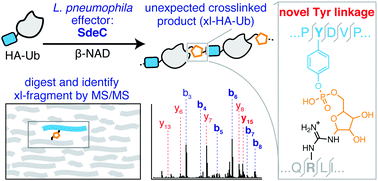
RSC Chem. Biol., 2021,2, 1509-1519
https://doi.org/10.1039/D1CB00088H
A cell permeable bimane-constrained PCNA-interacting peptide
A small, inherently fluorescent macrocyclic peptide constrained with a bimane-linker is cell permeable, and binds the human sliding clamp protein, PCNA, in a 310-helical conformation with nanomolar affinity.
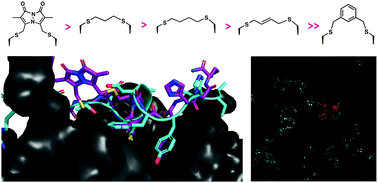
RSC Chem. Biol., 2021,2, 1499-1508
https://doi.org/10.1039/D1CB00113B
Entropy of stapled peptide inhibitors in free state is the major contributor to the improvement of binding affinity with the GK domain
The significant improvement in the binding affinity of the stapled peptide to the PSD-95 GK domain is mostly contributed by the reduction in the entropy penalty of the stapled peptide due to the restriction in the α-helical structure by stapling in the free state.
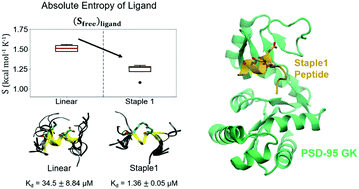
RSC Chem. Biol., 2021,2, 1274-1284
https://doi.org/10.1039/D1CB00087J
Deciphering the substrate recognition mechanisms of the heparan sulfate 3-O-sulfotransferase-3
Co-crystallization and biochemical analyses with structurally defined oligosaccharides show the low reactivity of HS 3-OST-3 toward 6-O-sulfated substrates is due to inhibition of enzyme activity by 6-O-sulfated oligosaccharides.

RSC Chem. Biol., 2021,2, 1239-1248
https://doi.org/10.1039/D1CB00079A
Glycan–protein interactions determine kinetics of N-glycan remodeling
Atomistic glycoprotein simulations reveal a site-specific availability of glycan substrates in time-resolved mass spectrometry of maturating enzyme kinetics.

RSC Chem. Biol., 2021,2, 917-931
https://doi.org/10.1039/D1CB00019E
The two domains of human galectin-8 bind sialyl- and fucose-containing oligosaccharides in an independent manner. A 3D view by using NMR
NMR, ITC, and MD data show that the two domains of human galectin-8 independently recognize sialyl- and fucosyl-containing glycans.

RSC Chem. Biol., 2021,2, 932-941
https://doi.org/10.1039/D1CB00051A
Bioorthogonal protein labelling enables the study of antigen processing of citrullinated and carbamylated auto-antigens
Click handle-containing antigens can be used to study uptake, processing and presentation by immune cells.

RSC Chem. Biol., 2021,2, 855-862
https://doi.org/10.1039/D1CB00009H
A two-trick pony: lysosomal protease cathepsin B possesses surprising ligase activity
Cathepsin B is an important protease within the lysosome, where it helps recycle proteins to maintain proteostasis.
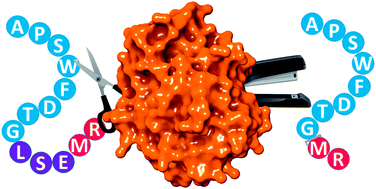
RSC Chem. Biol., 2021,2, 606-611
https://doi.org/10.1039/D0CB00224K
Membrane composition and lipid to protein ratio modulate amyloid kinetics of yeast prion protein
This study provides a mechanistic description of how the membrane composition and lipid to protein ratio modulate amyloid kinetics of yeast prion protein.
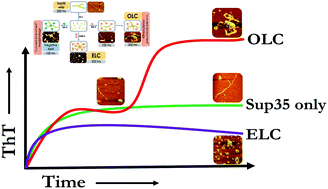
RSC Chem. Biol., 2021,2, 592-605
https://doi.org/10.1039/D0CB00203H
Metathramycin, a new bioactive aureolic acid discovered by heterologous expression of a metagenome derived biosynthetic pathway
Heterologous expression of an aromatic polyketide biosynthetic gene cluster recovered from a New Zealand soil metagenome library resulted in the discovery of new bioactive aureolic acids.
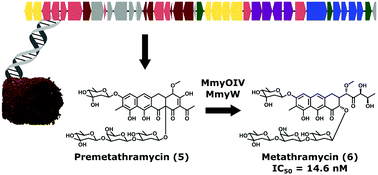
RSC Chem. Biol., 2021,2, 556-567
https://doi.org/10.1039/D0CB00228C
Identifying cysteine residues susceptible to oxidation by photoactivatable atomic oxygen precursors using a proteome-wide analysis
Evaluation of O(3P)-mediated cysteine oxidation in the proteome of a cell using dibenzothiophene-S-oxide derivatives as O(3P)-precursors.

RSC Chem. Biol., 2021,2, 577-591
https://doi.org/10.1039/D0CB00200C
Revision in the first steps of the biosynthesis of the red antibiotic prodigiosin: use of a synthetic thioester to validate a new intermediate
A revision is proposed to the biosynthetic pathway to the well-known red pigment prodigiosin via a new thioester intermediate.

RSC Chem. Biol., 2021,2, 551-555
https://doi.org/10.1039/D0CB00173B
Mechanism-based inhibitors of SIRT2: structure–activity relationship, X-ray structures, target engagement, regulation of α-tubulin acetylation and inhibition of breast cancer cell migration
Sirtuin 2 (SIRT2) is a protein deacylase enzyme that removes acetyl groups and longer chain acyl groups from post-translationally modified lysine residues. Here, we developed small peptide-based inhibitors of its activity in living cells in culture.
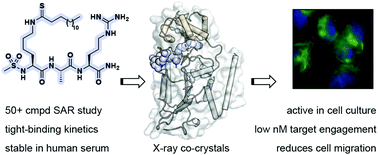
RSC Chem. Biol., 2021,2, 612-626
https://doi.org/10.1039/D0CB00036A
Light-induced modulation of DNA recognition by the Rad4/XPC damage sensor protein
Rad4/XPC DNA damage sensor protein specifically binds to a photocleavable NPOM-DNA adduct, and this recognition is abolished upon photo-cleavage of NPOM.

RSC Chem. Biol., 2021,2, 523-536
https://doi.org/10.1039/D0CB00192A
Site-specific modification and segmental isotope labelling of HMGN1 reveals long-range conformational perturbations caused by posttranslational modifications
Using protein semi-synthesis, segmentally isotope-labelled variants of nucleosome-binding protein HMGN1 were generated with site-specific posttranslational modifications to explore their structural and functional effects.

RSC Chem. Biol., 2021,2, 537-550
https://doi.org/10.1039/D0CB00175A
In vivo modulation of ubiquitin chains by N-methylated non-proteinogenic cyclic peptides
Cyclic peptides containing unnatural amino acids can modulate Lys-48 ubiquitin chains in cells and animals.

RSC Chem. Biol., 2021,2, 513-522
https://doi.org/10.1039/D0CB00179A
Bypassing the requirement for aminoacyl-tRNA by a cyclodipeptide synthase enzyme
Cyclodipeptide synthases recognize a minimalistic substrate to produce cyclic dipeptides in a tRNA-independent manner.
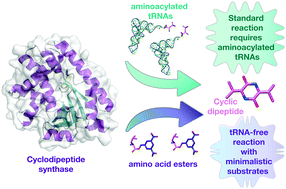
RSC Chem. Biol., 2021,2, 230-240
https://doi.org/10.1039/D0CB00142B
Finding and characterizing a catalytic antibody light chain, H34, capable of degrading the PD-1 molecule
Programmed cell death 1 (PD-1) is an immune checkpoint regulating T-cell function. A catalytic antibody light chain, H34, could enzymatically degrade the PD-1 molecule. In addition, it inhibited the binding of PD-1 with PD-L1.
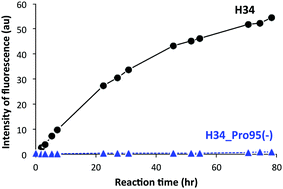
RSC Chem. Biol., 2021,2, 220-229
https://doi.org/10.1039/D0CB00155D
In silico peptide-directed ligand design complements experimental peptide-directed binding for protein–protein interaction modulator discovery
Using the protein–protein interaction of Mcl-1/Noxa, two methods for efficient modulator discovery are directly compared.
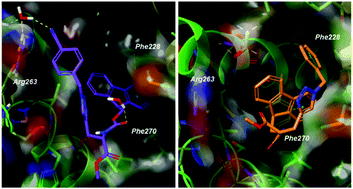
RSC Chem. Biol., 2021,2, 215-219
https://doi.org/10.1039/D0CB00148A
Fluorescent macrolide probes – synthesis and use in evaluation of bacterial resistance
Macrolide fluorescent probes illuminate the interactions between antibiotics and bacteria, providing new insight into mechanisms of resistance.
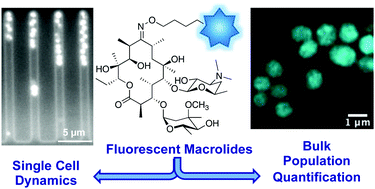
RSC Chem. Biol., 2020,1, 395-404
https://doi.org/10.1039/D0CB00118J
Cyclic peptide scaffold with ability to stabilize and deliver a helical cell-impermeable cargo across membranes of cultured cancer cells
A new helix-loop-helix peptide scaffold with dual ability to transport cargo across cancer cell membranes and disrupt mitochondrial membrane function.
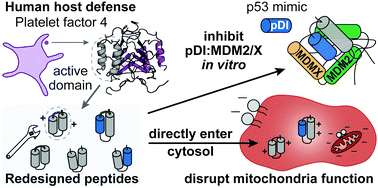
RSC Chem. Biol., 2020,1, 405-420
https://doi.org/10.1039/D0CB00099J
Structural and biophysical insights into the mode of covalent binding of rationally designed potent BMX inhibitors
We identified potent, functionalisable BMX inhibitors and revealed their covalent mode of binding to BMX by X-ray crystallography.
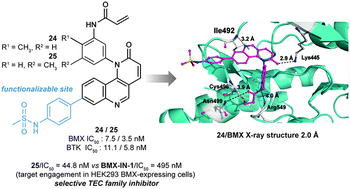
RSC Chem. Biol., 2020,1, 251-262
https://doi.org/10.1039/D0CB00033G
A thorough analysis and categorization of bacterial interrupted adenylation domains, including previously unidentified families
In-depth study of intriguing bacterial interrupted adenylation domains from seven distinct families and six different types.
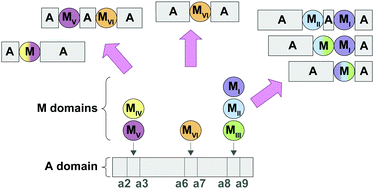
RSC Chem. Biol., 2020,1, 233-250
https://doi.org/10.1039/D0CB00092B
Antibacterial activity of a dual peptide targeting the Escherichia coli sliding clamp and the ribosome
Bifunctional peptides targeting both the translation and the replication machineries have been developed and shown to act as new antimicrobials.
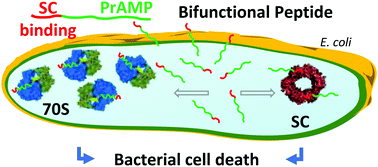
RSC Chem. Biol., 2020,1, 137-147
https://doi.org/10.1039/D0CB00060D
Wheat pathogen Zymoseptoria tritici N-myristoyltransferase inhibitors: on-target antifungal activity and an unusual metabolic defense mechanism
Investigation of the downstream effects of NMT inhibition identified novel defense mechanism against chemical toxicity in fungal pathogen Z. tritici.

RSC Chem. Biol., 2020,1, 68-78
https://doi.org/10.1039/D0CB00020E
A mechanism-inspired UDP-N-acetylglucosamine pyrophosphorylase inhibitor
UDP-N-acetylglucosamine pyrophosphorylase (UAP1) catalyses the last step in eukaryotic biosynthesis of uridine diphosphate-N-acetylglucosamine (UDP-GlcNAc), converting UTP and GlcNAc-1P to the sugar nucleotide.
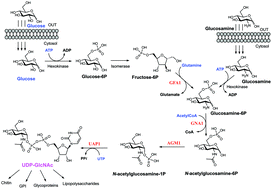
RSC Chem. Biol., 2020,1, 13-25
https://doi.org/10.1039/C9CB00017H
About this collection
In the interest of transparency and open science, RSC Chemical Biology is the first Royal Society of Chemistry journal to offer our authors the option of transparent peer review, where the editor’s decision letter, reviewers’ comments and authors’ response for all versions of the manuscript are published alongside the article under an Open Access Creative Commons licence (CC-BY). Authors are asked if they would like to take up this option at the revision stages. Reviewer comments will remain anonymous unless the individual chooses to sign their report.
For more information, please contact us.